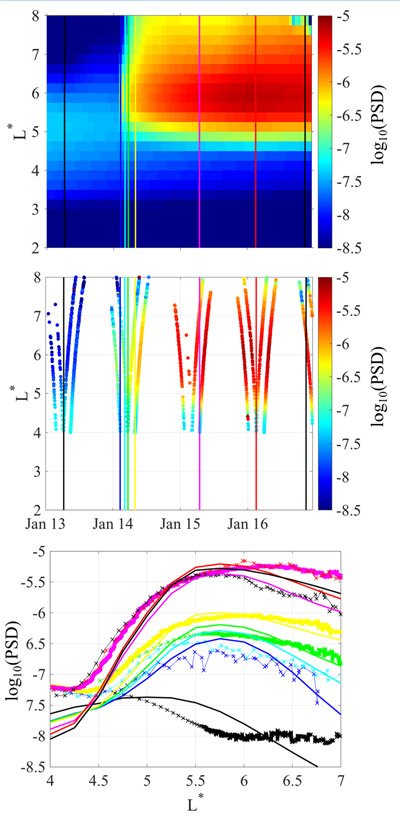
2017 THEMIS SCIENCE NUGGETS
Simultaneous event-specific estimates of transport, loss, and source rates for relativistic outer radiation belt electrons
by Quintin Schiller
NASA GSFC, CU LASP
Introduction
Energetic electrons in Earth's radiation belts have adverse effects on spacecraft, such as geosynchronous communication satellites. The most critical scientific question pertinent to understanding radiation belt flux levels are the relative contribution of simultaneous transport, loss, and source processes. Unfortunately, the three are very challenging to disentangle.
Due to the complex nature of observing the near-Earth system in conjunction with a sparsity of observations, it is common practice to make assumptions to quantify transport, loss, and source terms in models. For example, model terms can be generated from long averages of observations, or from individual historical events. However, it is well accepted that each event is unique and requires individualized event specific terms in the model to properly account for the ongoing physics. Previously, there have not been sufficient in-situ observations to separate the physical processes occurring for an individual event. The launch of NASA's Van Allen Probes mission in 2012 complements existing magnetospheric missions, such as THEMIS, enabling sufficient observations to begin unraveling the separate physical processes that dictate the net flux in the radiation belts.
We present modeling results that, for the first time, separate and quantify the transport, loss, and source terms from in-situ observations.
| Figure 1. Observations of the 2013 Jan 13-14 enhancement event. Panels a) and b) show solar wind speed and density respectively. Panel c) shows the interplanetary magnetic field in the z direction. Panels d)-f) show geomagnetic indices AE, Sym-H, and Kp respectively (where more positive values in AE and Kp and more negative values in Sym-H represent stronger geomagnetic activity). Panels g)-i) show ~0.6 MeV electrons from the THEMIS, Van Allen Probes, and Colorado Student Space Weather Experiment respectively. |
Methods and Results
A one-dimensional Fokker-Plank equation is used to model relativistic electrons, and requires terms for transport, loss, and source. In-situ electric and magnetic field observations from the Van Allen Probes mission are used to determine the transport term, in-situ particle observations from the Colorado Student Space Weather Experiment CubeSat are used to determine the loss term, and a data assimilative scheme using Van Allen Probes particle data is used to estimate the source term. The event-specific model is used to recreate the radiation belt environment for the 13-14 January 2013 enhancement event. The model performance is determined by direct comparison to Van Allen Probes and THEMIS observations.
The model with event specific terms accurately recreates the enhancement and subsequent decay. Additionally, it outperforms similar models with more generalized, yet commonly used, parameterized terms. THEMIS observations are used as an independent data set to compare against the results of the model.
| Figure 2. A comparison of the model to the independent THEMIS dataset to quantify model performance. The top panel shows model results and the middle panel shows THEMIS observations. The colored vertical lines indicate radial cuts in both the model results and the THEMIS observations at various time steps. The two are plotted against each other in the bottom panel. |
Conclusion
The individual estimates of transport, loss, and source rates provide a better understanding of the physical processes involved with this enhancement, in which there is a dramatic acceleration of electrons despite the relatively small geomagnetic signature. Additionally, the enhancement is shown to be dominated by local acceleration, with the inward radial transport playing a significantly smaller role. The enhancement also dominates concurrent losses, and results in insights towards the absolute strength of the energizing process. In contrast, identical experiments with more commonly used parameterized terms do not match independent observations from THEMIS. As adamantly demonstrated by this study, event-specific terms should be used to model radiation belt enhancements when possible.
The ability to separate transport, loss, and source terms in the radial diffusion model is made possible by the large number of conjunctive space physics missions in operation. These missions include flagship missions like the Van Allen Probes, Explorer-class missions like THEMIS, and small, inexpensive, but less robust CubeSat platforms.
Reference
Schiller, Q., W. Tu, A. F. Ali, X. Li, H. C. Godinez, D. L. Turner, S. K. Morley, and M. G. Henderson (2017), Simultaneous event-specific estimates of transport, loss, and source rates for relativistic outer radiation belt electrons, J. Geophys. Res. Space Physics, 122, doi:10.1002/2016JA023093.Biographical Note
Quintin is a postdoctoral fellow at NASA Goddard Space Flight Center. His research focuses on the dynamics of the highest-energy particles in the heliosphere via data analysis, modeling, and instrument development.
 Please send comments/suggestions to
Emmanuel Masongsong / emasongsong @ igpp.ucla.edu
Please send comments/suggestions to
Emmanuel Masongsong / emasongsong @ igpp.ucla.edu


